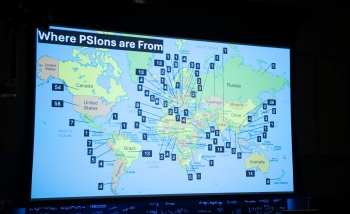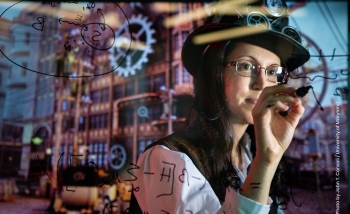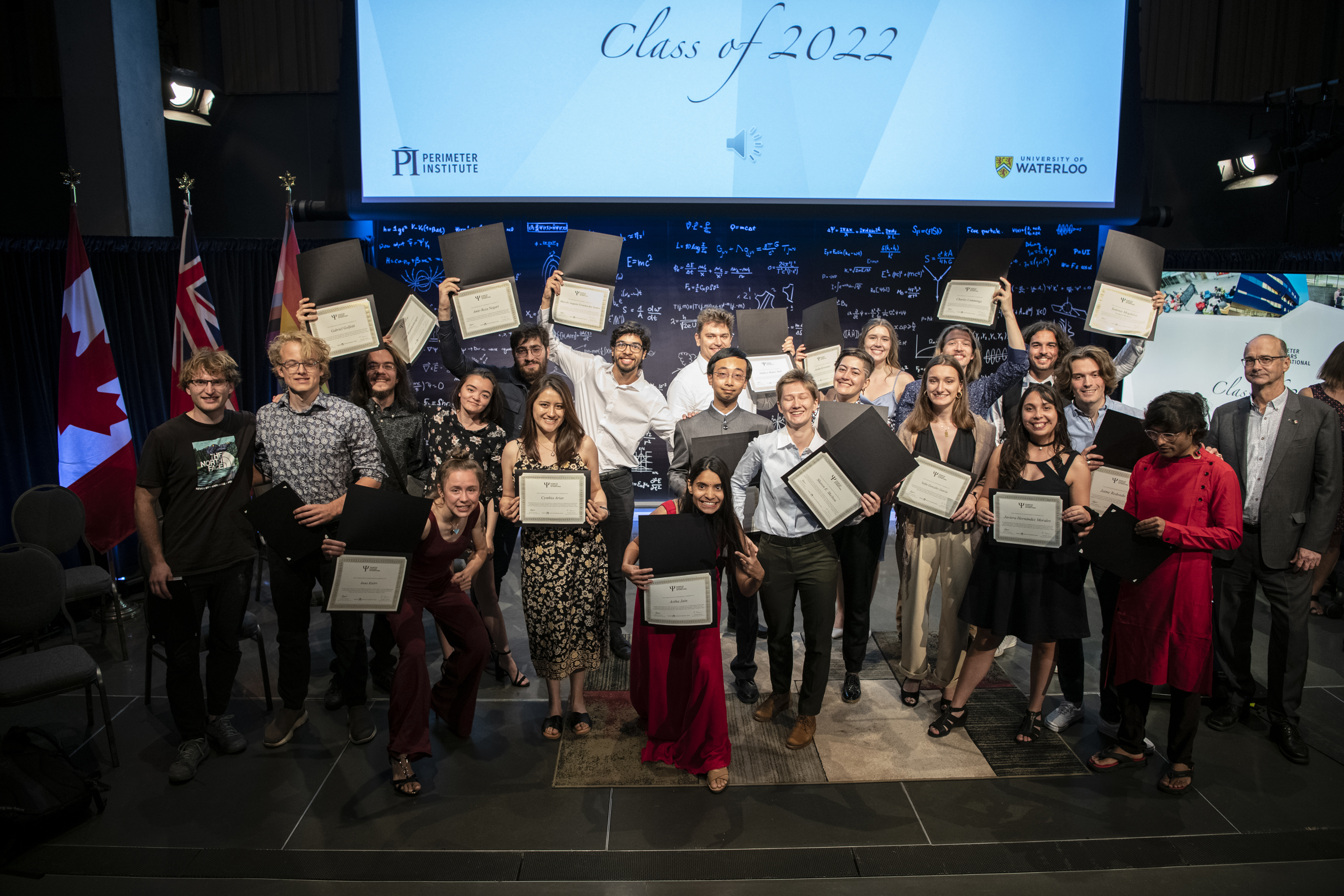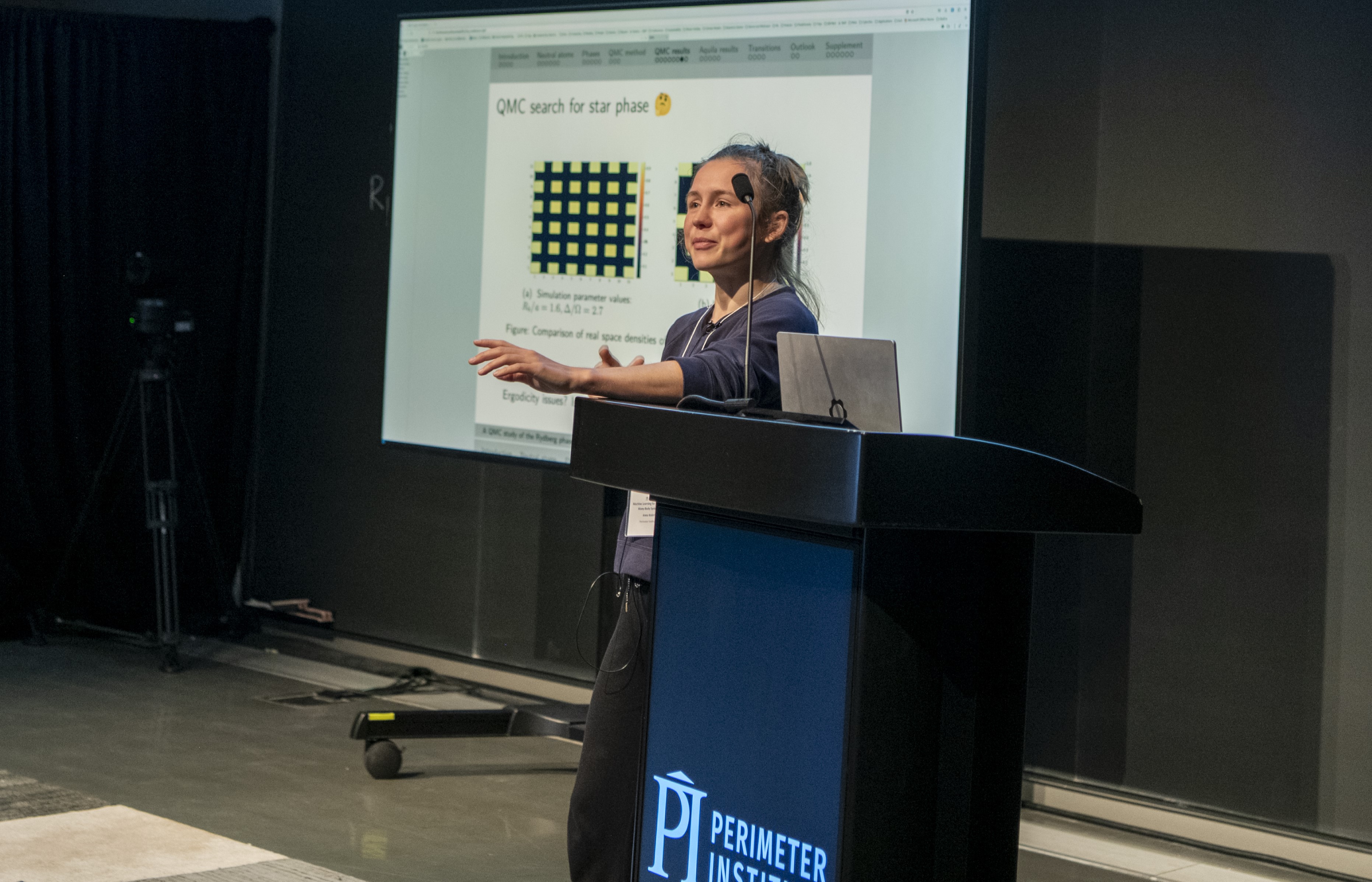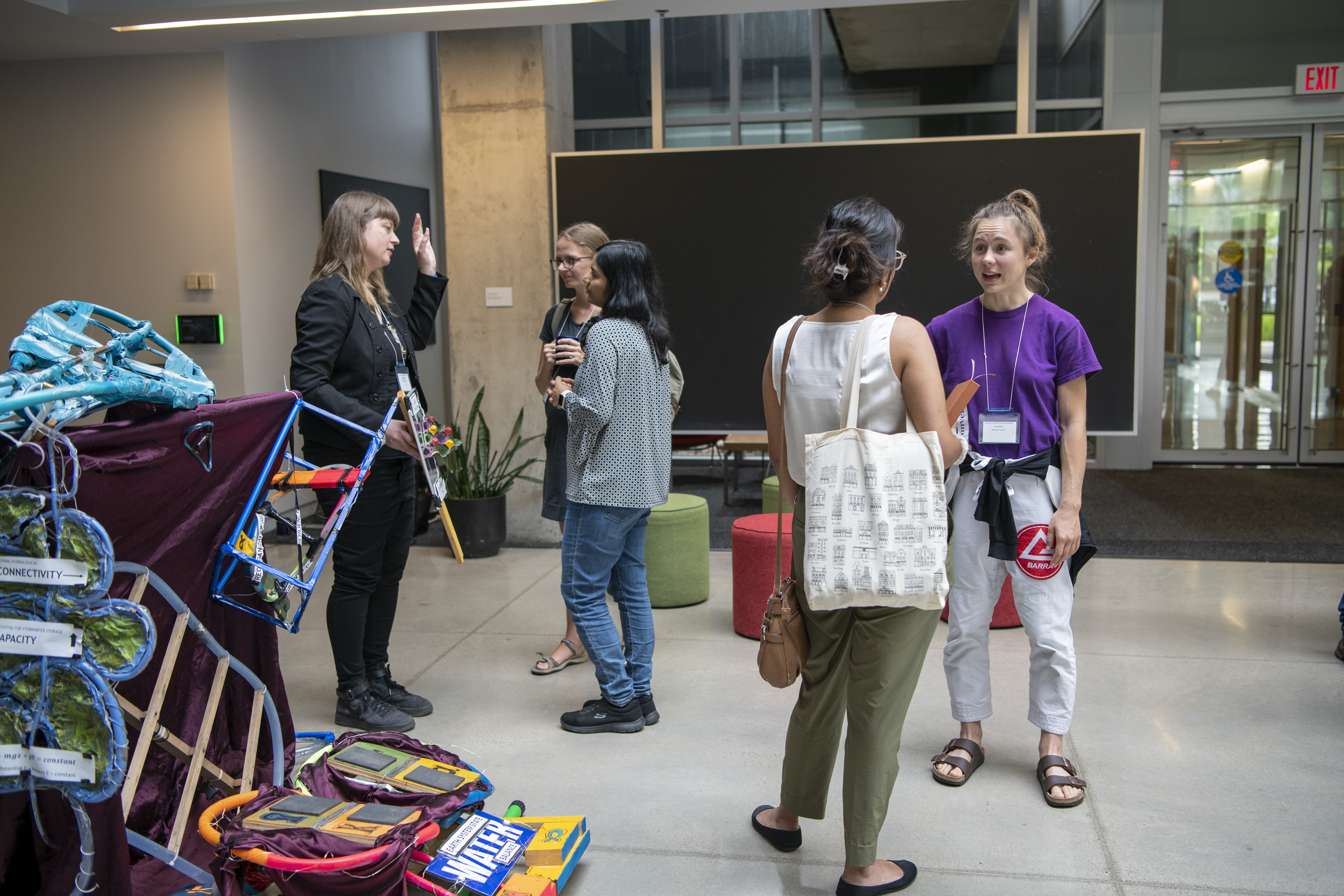Bye bye, Waterloo. As the taxi leaves Caroline Street behind, I wave goodbye to the flocks of geese that guard Perimeter during the warm months from spring to fall. How often did we joke (in fear) about these ferocious, deeply Canadian animals during the past two years?
Yes, it has been two years, not the usual ten months of PSI for me. I am very grateful that PI did not eject me before I was ready to go. Many students arrive at the PSI program with a potential next destination in mind – some may have even already secured a PhD position and slot in Perimeter’s ten-month master’s program as an extra pre-PhD boost.
When I first walked through Perimeter’s doors, however, thoughts about where to go next were the last thing on my mind. Having spent my three undergrad years surrounded by roughly 10,000 undergrads, 5,000 PhD students, and 500 professors, the ratios at PI were quite a change: roughly 20 master-level PSIons, just over 50 resident PhD students, and 50 research faculty, plus a constant stream of distinguished visitors. I really felt like a little gosling with a lot to learn. In that moment, PhD applications seemed to me (almost) as distant as looking for a job when you start middle school.
Arriving at Perimeter
The first few months of PSI flew by. Grappling with black holes, Feynman diagrams, and renormalized infinities while getting to know my family-away-from-home – i.e., my 20 fellow students from 11 different countries – was enough to keep my mind spinning. I am still in awe of others in the cohort who simultaneously churned out up to 12 US PhD applications. Even though many of them were already familiar with the system, managing the daily workload together with the application frenzy proved to be the toughest phase of the program.
Spring arrived, and so did the first responses from US universities. PhD application windows in Europe began to open as well. The latter system, being more familiar and hence less daunting, I did momentarily take a shot at writing a letter of motivation. Yet this attempt brought home to me an obvious fact: You need to know what to write. You need to first convince yourself about which specialized topic you will be motivated to work on for an extended period of time.
Beginning to gain research experience
During my undergrad, engaging with research had not been a top priority. My bachelor’s degree had been designed in sequential fashion, focused on lectures and exams, with the aim of providing us with a solid foundation before moving on to in-depth research during the ensuing master’s.
Already I’d experienced a slight academic culture shock during my very first days at Perimeter, when fellow PSIons from Canada or the US, for example, recounted long lists of small research projects they had performed in parallel to their undergraduate studies. This had helped them start figuring out early on which areas of research made their curiosity tingle.
The first year of PSI had certainly helped put me on the path to answering that question of interest and motivation. Being constantly surrounded by research life in the form of ubiquitous blackboard discussions, seminars, and lunchtime conversations with other graduate students, postdocs, faculty, and research visitors, PSI had successfully broken me out of a mindset of mastering textbooks and exercises.
Yet the end of that path was not yet in sight for me. Instead, I felt PSI had opened a vast vista of unanswered physics questions, and I would need more time to digest all the input. Only then would I be able to narrow down and feel confident about which research area I could see myself specializing in.
Piloting the PSI internship option
With another PSIon having similar feelings, we sat down with our study coordinators, Maïté Dupuis and Lauren Hayward, to figure out whether we might possibly stay at Perimeter for another year. With both of us having started research projects in the field of quantum information during our first PSI year, we landed on the idea of pursuing internships in the growing quantum industry to complement Perimeter’s academic environment.
Thanks to the invaluable support of PI’s academic staff and my supervisor, Roger Melko – as well as a stroke of luck! – my second year of PSI began not in Waterloo, but in Boston at QuEra Computing Inc. As part of the scientific software team, I was tasked with building a Quantum Monte Carlo (QMC) library based on QMC code previously written by other students in Roger’s research group, Ejaaz Merali and Isaac de Vllugt. This code would expand the toolbox offered by QuEra’s open-source platform, Bloqade, for quantum simulation and computation.
Internships in quantum industry
With pull requests and integration tests as my daily bread, this project certainly helped me work on my GitHub skills beyond the basic commit & push. Writing tutorials taught me that your package is only as good as your user interface. Being immersed in the debates of quantum industry also provided me with a bigger picture: What are current trends in global quantum investment? How does academic research feed into commercially useful products? What use cases will the market demand five years down the road?
Most of all, I was immensely lucky to witness the launch of QuEra’s first quantum computer: Aquila boasts 256 qubits based on neutral atom quantum technology and is publicly accessible via cloud services. As the long-awaited release date drew near, it was inspiring to see the whole start-up pool its efforts, working together on a tight schedule to make the product launch happen.
With the machines being built right in the next room, I got to stop by for regular chats with the experimentalists to learn the nuts and bolts of neutral atoms – a real treat. It’s good to be reminded that theory only gets you so far. Representing QuEra at conferences such as Perimeter’s “New Frontiers in Machine Learning and Quantum” further gave me opportunities to practice giving both company pitches and scientific presentations in public.
As 2022 drew to an end, I felt the second year of PSI had already paid off. My head was no longer whirling around. The way that quantum research brings together abstract formalisms with real-world applications was a clear attraction to me, as was the juicy mix of coding, theoretical algorithms, and hands-on hardware. The prospect of collaborating closely with researchers outside of physics – be it chemistry, biology, or computer science – was invigorating. Finally, I felt I could sit down to write an honest statement of purpose, grounded in research experience I had lacked the year before.
Adding the social dimension of quantum technology
Yet the second year certainly still had much more in store for me. After a refreshing winter break aboard Via Rail’s five-day train across Canada, the new year added another dimension to my quantum journey: Two fellow graduate students in Waterloo and Boston, Joan Étude Arrow and Rodrigo Araiza Bravo, introduced me to discussions regarding the societal impacts of quantum technology. Together with a Discord server full of other students, we started building the Quantum Ethics Project (QEP).
Our aim was and is simple: As quantum technologies (hopefully) start living up to their anticipated impact over the next decade, numerous questions will arise: Who will benefit most from their development? Who will be included in the specialized workforce? We wanted to get a head start by asking such questions while the technology is still hot, before quantum becomes firmly embedded into society, economy, and policy.
In fact, such questions are already relevant today. For example, how do we maintain a healthy level of hype? On the one hand, generating collective excitement about the potential of quantum technologies can motivate researchers to try harder. On the other hand, bestsellers boasting unrealistic statements such as “There is not a single problem humanity faces that couldn’t be addressed by quantum computing”¹ may create public expectations that cannot be fulfilled. Hopefully, we can find a balance that sustains public trust and support throughout any rocky research roads ahead.
Perimeter nourishes thinking outside of the technical box
I felt intrigued by this anticipatory approach to the ethics of cutting-edge technology. Together with friends from the QEP, I approached PI’s Inclusion platform² and soon we had a working group with a small budget set up under its umbrella. This allowed us to host events and further discussions between technical researchers and social scientists.
Indeed, Perimeter as a whole proved to be an ideal environment to nourish these efforts. Thanks to PI’s Career Trajectories team, we were able to host a quantum ethics workshop as part of a larger course on quantum and AI. Thanks to PI’s extensive network, we were able to exchange thoughts with leading quantum researchers such as Raymond Laflamme, co-chair of Canada’s National Quantum Strategy Advisory Council, as well as politicians such as Bardish Chagger, the MP for Waterloo. For World Quantum Day 2022, we organized a virtual panel discussion themed around how national interests and geopolitics are influencing current global quantum development.
Overall, I believe these opportunities have only deepened my interest in science and technology, quantum included, by showing me how rich the subject can be beyond the purely technical.
Leaving PSI with purpose
There are many more stories I could tell about both years I got to spend at Perimeter. But if there is one note I’d like to leave potential future PSIons with, it is the fact that even though PSI may appear to be a focal point for theoretical physics nerds (which it absolutely is), it by no means pushes you in that direction. Indeed, some of the brightest in our cohort are now rocking the stage in Brazilian bars, teaching primary school children, or writing poetry. PSI is not a single-track road.
In my case, it just took me another round to figure out in which direction I could feel my winds blow. Now, I am ready and excited to start a PhD position in Quantum Science & Engineering at the Harvard Quantum Initiative. In this next chapter, I won’t forget the core lesson that PSI taught me: to not let anything stand in your way of being curious.
Feel free to reach out to me via atomyka.com, where you can also find another report (with many photos!) about the first PSI year.
Anna also thanks the Swiss Study Foundation for two years of financial support through an Annual Scholarship as well as a Werner Siemens Fellowship.
¹Quantum Supremacy – How the Quantum Computer Revolution Will Change Everything, Michio Kaku (https://www.penguinrandomhouse.com/books/697040/quantum-supremacy-by-michio-kaku/)
²For incoming students, researchers and staff who want to engage in climate action, reach out to the PI Climate Working Group which is also part of PI’s Inclusion platform. Activities range from practical discussions around retrofitting PI’s building to exchanging thoughts with climate-related researchers at events such as the Hammers & Nails climate workshop.
About PI
Perimeter Institute is the world’s largest research hub devoted to theoretical physics. The independent Institute was founded in 1999 to foster breakthroughs in the fundamental understanding of our universe, from the smallest particles to the entire cosmos. Research at Perimeter is motivated by the understanding that fundamental science advances human knowledge and catalyzes innovation, and that today’s theoretical physics is tomorrow’s technology. Located in the Region of Waterloo, the not-for-profit Institute is a unique public-private endeavour, including the Governments of Ontario and Canada, that enables cutting-edge research, trains the next generation of scientific pioneers, and shares the power of physics through award-winning educational outreach and public engagement.
You might be interested in

